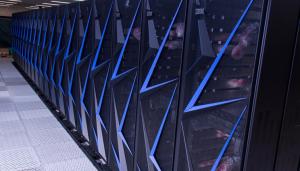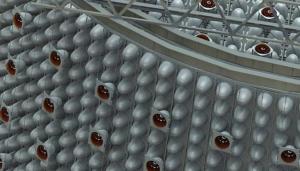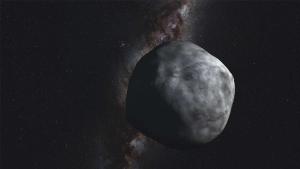LAB REPORT
Science and Technology Making Headlines
April 6, 2018


A new 3D-printing technique, developed at Lawrence Livermore, could allow scientists to print glass that incorporates different refractive indices in a single flat optic, making finishing cheaper and easier. Photos by Jason Laurea/LLNL
Through the looking glass
Lawrence Livermore researchers always impress with their many 3D printing innovations. Their expertise is especially apparent when it comes to their work with materials, from carbon fiber to advanced stainless steel and other metals to reactive materials and metamaterials with shape memory behavior.
Last year, a team of researchers from LLNL developed a method for 3D printing glass using direct ink writing and published a paper on their work. The method differed from typical 3D printing because the glass could be 3D printed at room temperature out of an ink formulated from concentrated silica particle suspensions.
LLNL has been building on this innovative research, and researchers have successfully 3D printed optical-quality glasses that, for the first time, are on the same level as currently available commercial glass products.


Lawrence Livermore is preparing Sierra, the Lab’s next advanced technology high-performance supercomputer. Sierra will be used for stockpile stewardship.
Exascale moving forward
The federal government’s Fiscal Year 2018 (FY18) budget is complete and ended with some very positive news for the Department of Energy (DOE) and the National Nuclear Security Administration’s exascale activities DOE’s Exascale Computing Initiative (ECI) saw significant budget growth. The goal of ECI is to establish a “productive” exascale system in the United States by 2021, with several follow-on installations.
ECI consists of two major parts. One is the activities associated with the procurement of systems to support the computing capabilities at the national laboratories facilities. This work is being done through the CORAL-2 acquisition process and will include Non-Recurring Engineering work, site preparation and installation of exascale computing system CORAL (Collaboration of Oak Ridge, Argonne and Livermore).
The other part of ECI is known as the Exascale Computing Project (ECP), an official Office of Science project that is jointly supported by SC/ASCR and the NNSA Advanced Simulation and Computing (ASC) program. The NNSA exascale system is expected to start its installation at LLNL in 2022.


This graphic shows the detail of a possible configuration of the photomultiplier tube mounting structure for the WATCHMAN antineutrino detector. Drawing by Jim Brennan/Sandia National Laboratories, California
I spy a nuclear reactor
A consortium of American and British science institutions, led by Lawrence Livermore, is working on a way to use antineutrinos to remotely monitor nuclear reactors.
Sponsored by the Department of Energy's National Nuclear Security Administration, the Advanced Instrumentation Testbed (AIT) program is installing the 3,500-ton WATer CHerenkov Monitor of ANtineutrinos (WATCHMAN) detector in a 1,100-meter-deep (3,600 feet) mine located on the northeast coast of England as part of international nuclear weapon nonproliferation efforts.
One promising method for doing this uses antineutrinos. Discovered in 1950, the antineutrino is the antimatter version of the neutrino and is produced in nuclear reactions when a neutron decays into an electron, a proton and a neutrino. Like the neutrino, antineutrinos are the tiniest of elementary particles, with a mass a million times smaller than an electron and no electric charge.
Trying to detect antineutrinos may sound a bit pointless, but according to physicists, if you take a tank of water 52 feet tall and 16 meters in diameter and dope it with trace amounts of the rare earth metal gadolinium, it makes the protons in the water much more sensitive to antineutrinos. Such a tank is the central component of WATCHMAN.


An artist’s rendering of the asteroid Bennu.
Asteroid could take a HAMMERing
On a Sunday morning in September about 117 years from now, a 1,640-foot asteroid will fly past Earth five times closer than the moon. The asteroid has a one-in-2,700 chance of hitting the planet on Sept. 25, 2135.
The asteroid is not just another anonymous space rock but is actually quite well known. Its name is Bennu and NASA currently has a mission that aims to go to the asteroid, collect a sample and then return it to Earth in 2023. The asteroid was selected because it is a remnant of the early solar system and it could help us understand the beginning of Earth in greater detail.
If Bennu was to hit Earth, the impact would have a kinetic energy equivalent to 80,000 Hiroshima nuclear bombs, about 1,200 megatons.
“The chance of an impact appears slim now, but the consequences would be dire,” said Kirsten Howley from the Lawrence Livermore National Laboratory. “This study aims to help us shorten the response timeline when we do see a clear and present danger, so we can have more options to deflect it. The ultimate goal is to be ready to protect life on Earth.”
The mission is called Hypervelocity Asteroid Mitigation Mission for Emergency Response vehicle, or HAMMER, in which the spacecraft can be rammed into the asteroid. This impact would nudge the asteroid on a slightly different orbit.


Operation Nutmeg, a 25.1 kiloton nuclear test, is one of 750 nuclear films that have been declassified.
Boom goes the … nuke
Between 1945 and 1962, the U.S conducted 210 atmospheric nuclear tests.
Each explosion was recorded using 50 separate cameras. There are about 10,000 films total but only about 750 of those have been declassified.
The films on are the brink of decomposing so Lawrence Livermore scientists are working to digitize all the files, so they can reanalyze the nuclear yield of each test.





